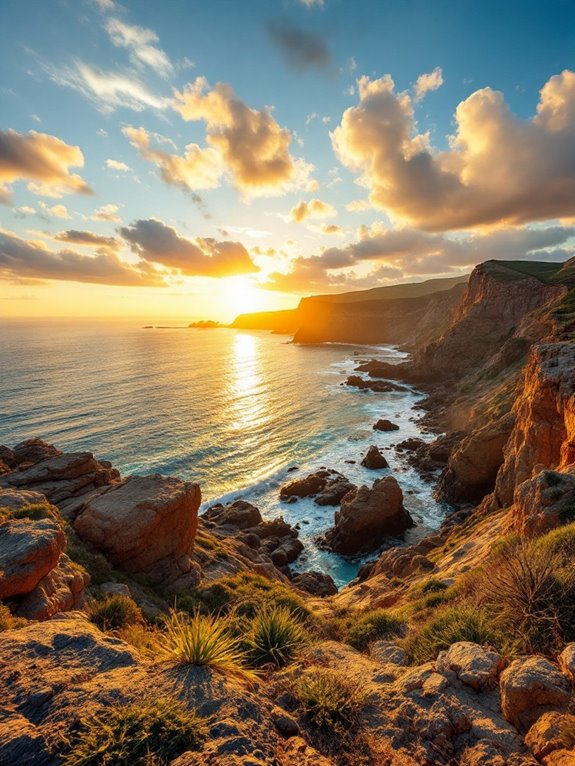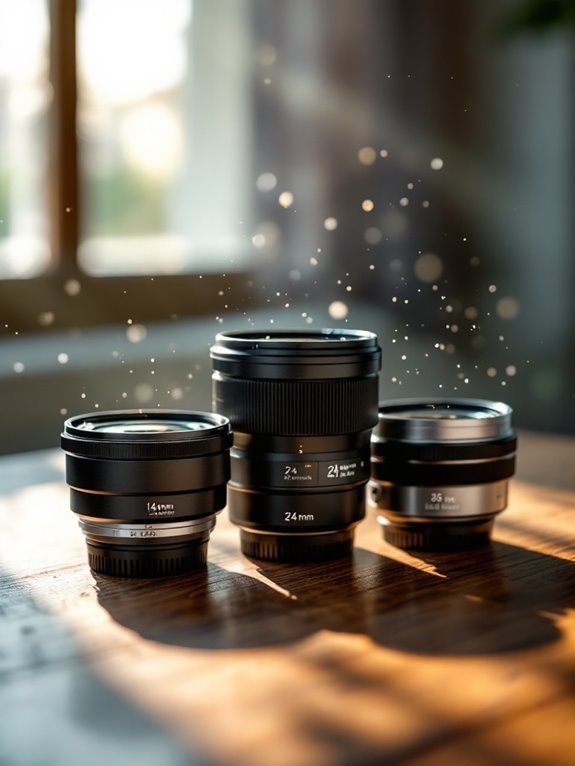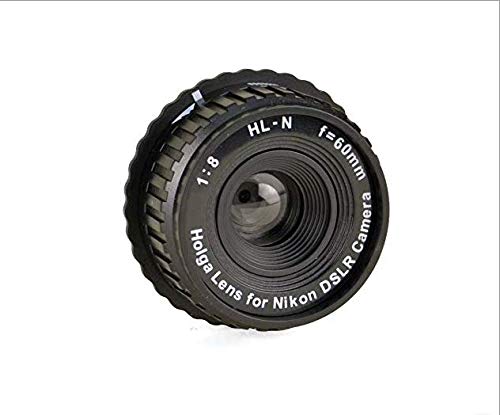For wide-angle photography, three top options stand out: SIRUI Sniper 23mm F1.2 offers impressive low-light capability with its F1.2-F16 aperture range, though best sharpness requires stopping down to F1.8. Holga HL-N 60mm f/8 provides creative effects through its fixed aperture and lightweight 30g plastic construction. OPTURA HD OPTICS features multi-coated glass that reduces flare and adds 2.2X magnification to compatible Canon lenses. Further examination of each lens’s build quality and focal characteristics reveals their distinct performance advantages.
Key Takeaways
- SIRUI Sniper with its 23mm focal length is ideal for wide-angle photography on Sony E-mount cameras.
- Wide lenses like the SIRUI Sniper offer aperture ranges from F1.2-F16, enabling excellent low-light performance and depth control.
- The carbon body construction of the SIRUI Sniper reduces chromatic aberration through its 12-element design with ED glass.
- For Nikon users, the lightweight Holga HL-N provides creative wide-angle effects with its 60mm focal length.
- Wide lenses typically incorporate multi-coated glass to minimize flare and ghosting while maximizing contrast and color accuracy.
OPTURA HD OPTICS 2.2X Telephoto Lens for Canon Cameras (58mm)
- 58mm 2.2X Telephoto Lens for Canon Rebel T3, T3i, T5, T5i, T6, T6i, T7i, EOS 80D, EOS 77D Cameras with Canon EF-S 18-55mm f/3.5-5.6 IS II, IS STM Lens
- Ideal for adding the extra zoom you need, bring your subject closer to you! - 2.2x Telephoto lens brings you twice as close to the action - double your zoom!
- Perfect for long-distance photo situations such as sporting events; candid portrait shots, as well as nature and wildlife photography
Photography enthusiasts seeking to extend their reach without investing in expensive prime lenses will find the OPTURA HD OPTICS 2.2X Telephoto Lens a practical solution for long-distance photography. This 58mm telephoto converter effectively doubles the zoom capability of compatible Canon lenses, making it suitable for sports photography, wildlife observation, and portrait work.
The lens features multi-coated optical glass to minimize flare and ghosting, while its steel barrel construction guarantees precision alignment. Compatibility extends to numerous Canon models including the Rebel series (T3-T7i) and EOS 80D/77D cameras when paired with EF-S 18-55mm lenses. User feedback indicates potential image quality issues at extreme focal lengths, resulting in a moderate 3.6/5 star rating.
Best For: Amateur photographers using compatible Canon cameras who need an affordable way to increase zoom capability for distant subjects like wildlife, sports, or candid portraits without investing in expensive prime telephoto lenses.
Pros:
- Doubles zoom capability with 2.2X magnification, extending the reach of compatible Canon lenses
- Multi-coated optical glass reduces unwanted flare and ghosting for clearer images
- Durable steel barrel construction ensures precision alignment and longevity
Cons:
- User feedback reports image quality issues including blurry photos at extreme focal lengths
- May cause foggy viewfinder or photos when used beyond 500mm telephoto zoom
- Limited compatibility only with specific Canon models and the EF-S 18-55mm lens series
Holga HL-N 60mm f/8 Lens for Nikon DSLR Camera Black
- The Holga lens can be used with ANY Nikon DSLR/SLR Cameras
- A kind of plastic lens that can be mounted to Nikon cameras directly
- By using it, the Nikon DSLR cameras can also shoot pictures with soft and dark angle effects, just like Holga film cameras.
Creative photographers seeking nostalgic film aesthetics in digital photography will find the Holga HL-N 60mm f/8 lens an intriguing addition to their equipment arsenal. This lightweight plastic lens, weighing merely 30g with dimensions of 30x60mm, mounts directly to Nikon F-mount DSLRs to produce distinctive visual characteristics including vignetting, soft focus, and light leaks reminiscent of traditional Holga film cameras.
The lens features a fixed f/8 aperture with manual focus capabilities, offering a 60mm focal length that performs best between approximately 15 feet to infinity. Released in April 2019 by manufacturer Sunrise, this lens has garnered a 4.1/5 star rating across 52 customer reviews, with users particularly noting its effectiveness for creative portraiture and experimental photography where technical imperfections contribute to artistic expression.
Best For: Creative photographers who want to achieve vintage, unpredictable film aesthetics on their Nikon DSLR cameras without investing in an actual Holga film camera.
Pros:
- Extremely lightweight (30g) plastic construction makes it highly portable and easy to carry as a creative alternative lens
- Creates authentic Holga-style effects including vignetting, soft focus, and unique distortions that are difficult to replicate with post-processing
- Very affordable compared to traditional lenses, offering a fun way to experiment with artistic photography
Cons:
- Fixed f/8 aperture severely limits shooting conditions, requiring good lighting or slower shutter speeds
- Loose mounting to camera body reported by some users, potentially causing alignment issues
- Limited focus range with best results approximately 15 feet to infinity, making close-up photography challenging
SIRUI Sniper 23mm Autofocus Wide Angle Camera Lens (F1.2, E Mount)
- SIRUI Sniper series lenses are the most budget-friendly F1.2 AF lens in the market. Consisting of 23mm, 33mm, and 56mm, it is a fusion of speed, precision, and artistic...
- Swift & Silent Auto-Focus: Equipped with STM (stepping) focus motors, the auto-focus system of the SIRUI Sniper lens, supporting eye AF tracking, locks onto subjects with...
- Minimal focus breathing and strictly controlled aberration allow focusing on the subject from beginning to end. ED glass and high refractive index glass are added to...
The SIRUI Sniper 23mm F1.2 stands as an exceptional choice for budget-conscious photographers and videographers seeking premium performance on Sony E-mount cameras without premium pricing. This lens features 12 elements in 11 groups with an 11-blade aperture system, delivering impressive low-light capabilities with its F1.2-F16 aperture range and minimum focus distance of 0.3m. STM motors enable silent, swift autofocus with effective eye tracking, while the optical design, incorporating ED glass elements, minimizes chromatic aberration and controls flare.
The carbon body construction balances durability with portability at 380g, measuring 79mm in diameter and 92.5mm in length.
Best For: Aspiring photographers and videographers using Sony APS-C cameras (like A5, A6, FX30, ZV-E10) who want professional-quality wide-angle results with excellent low-light performance at an affordable price point.
Pros:
- Impressive F1.2 maximum aperture delivers exceptional low-light performance and beautiful bokeh, making it versatile for both photography and videography
- Fast, quiet STM autofocus motors with eye-tracking capability ensure accurate focus for both stills and moving subjects
- Lightweight carbon body (380g) balances portability with durability, making it comfortable for all-day shooting sessions
Cons:
- Some users report noticeable color aberration and green color cast that requires correction in post-processing
- While sharp at center, edge-to-edge sharpness and contrast improve only when stopped down to F1.8 or higher
- Focus breathing is present although minimal, which may impact professional video work that requires precise focus pulls
Factors to Consider When Choosing a Wide Camera Lens

When selecting a wide camera lens, you’ll need to verify mount compatibility with your specific camera body, as different manufacturers utilize proprietary mounting systems that aren’t universally interchangeable. The aperture range (typically expressed as f/1.2-f/16) determines both your low-light performance and depth-of-field control, with wider apertures allowing for better light gathering capability but often at higher price points. Your intended photography style should dictate focal length options, with ultra-wide (14-20mm), standard wide (21-35mm), and moderate wide (35-40mm) each offering different fields of view, perspective characteristics, and varying degrees of distortion at the frame edges.
Mount Compatibility
Understanding mount compatibility constitutes an essential first step when selecting a wide-angle lens for your camera system. Your camera’s mount type determines which lenses can physically attach to your body, with systems varying between manufacturers like Canon, Nikon, Sony, and Fujifilm. The bayonet-style mounts found on most modern cameras feature precise connection points that maintain critical flange distances of 16.5mm to 46.5mm, depending on the system.
The mount interface controls not only physical attachment but also electronic communication between lens and camera. This connection enables essential features including autofocus operation, aperture control, and metadata recording. When evaluating compatibility, you’ll need to confirm both the physical mount designation (RF, F-mount, E-mount, X-mount, etc.) and electronic protocols supported. Incompatible systems will require adapters that may compromise autofocus speed by 40-70% and potentially eliminate electronic aperture control.
Aperture Range
Aperture range represents a critical specification when evaluating wide-angle lenses, determining both light-gathering capabilities and creative potential across various shooting scenarios. Wide-angle lenses offering larger maximum apertures (f/1.4, f/2.8) deliver superior low-light performance, allowing faster shutter speeds without compromising exposure quality. These wider apertures also produce more pronounced bokeh effects, creating pleasing background separation despite the inherently greater depth of field in wide-angle photography.
Conversely, narrower minimum apertures (f/16, f/22) provide extended depth of field capabilities, essential for landscape photography where foreground-to-background sharpness is paramount. For maximum versatility, select lenses with extensive aperture ranges, such as f/1.4 to f/22, enabling adaptation to diverse lighting conditions and creative requirements. This specification directly impacts your ability to execute various photographic styles with a single lens, from environmental portraits to sweeping landscapes.
Focal Length Options
The focal length specification directly determines the angular field of view your wide-angle lens can capture, making it perhaps the most definitive characteristic to evaluate when selecting this type of optic. Wide-angle lenses typically range from 14mm to 35mm, with each increment offering distinct compositional advantages. Ultra-wide focal lengths (14-20mm) excel at capturing expansive landscapes and architectural interiors while dramatically emphasizing foreground elements, though they introduce noticeable distortion.
Moderate wide-angles (24-28mm) provide a balanced perspective that minimizes distortion while maintaining an impressive field of view, making them versatile for street photography and everyday documentation. As you approach 35mm, you’ll notice a narrower angle that renders scenes more naturally. Your selection should align with your primary shooting scenarios, considering the relationship between focal length, distortion levels, and depth perception characteristics.
Build Material Quality
Superior construction materials form the foundation of a wide-angle lens’s long-term performance and reliability, differentiating professional-grade optics from consumer alternatives. Metal-constructed lenses, particularly those utilizing aircraft-grade aluminum or magnesium alloys, deliver exceptional durability against impact and environmental stressors, outperforming plastic counterparts by significant margins. Your investment in weather-sealed construction with rubberized gaskets guarantees consistent performance across temperature ranges (-10°C to 40°C) and humidity conditions (15-85%).
Material precision directly correlates with optical alignment stability—high-grade metals maintain positioning tolerances of ±0.001mm compared to plastic’s ±0.005mm variance. While metal construction typically adds 15-25% to overall weight, this trade-off provides measurable longevity benefits, with professional metal bodies maintaining calibration for 7-10 years versus 3-5 years for consumer-grade materials under identical usage patterns.
Weight and Portability
While material construction establishes durability parameters, weight considerations directly impact your day-to-day shooting experience with wide-angle lenses. Weight variations among wide lenses range dramatically from sub-100g compact models to professional-grade options exceeding 800g, with significant implications for usability.
Wide lenses weighing under 500g minimize fatigue during extended shooting sessions, making them ideal for travel photography or nature excursions where equipment must be carried for hours. Models below 300g offer superior portability, allowing for quicker deployment and reduced camera bag space consumption—a critical factor for spontaneous shooting opportunities.
Heavier models (700g+) often deliver premium optical performance but necessitate consideration of total system weight when paired with camera bodies. Weight distribution, not merely total mass, determines how a lens balances on your camera, affecting stability during dynamic shooting scenarios.
Optical Coating Performance
Modern optical coatings represent a critical, yet often overlooked, component in wide-angle lens performance, functioning as invisible guardians against image-degrading optical phenomena. These multi-layer treatments greatly reduce internal reflections, minimizing flare and ghosting that commonly plague wide-angle photography in high-contrast situations.
High-performance coatings enhance light transmission efficiency up to 99% per surface, delivering superior results in challenging low-light conditions. Your wide-angle lens’s ability to suppress chromatic aberrations depends substantially on coating quality, directly affecting color accuracy and edge-to-edge sharpness. Contrast ratios improve markedly with premium coatings, as scattered light reduction creates more defined details across the frame. When evaluating lens options, consider coating durability factors such as moisture resistance and scratch protection, which guarantee consistent optical performance throughout the lens’s operational lifespan.
Autofocus Vs Manual
Beyond coating quality, the focusing mechanism of your wide-angle lens represents a fundamental decision point with significant implications for your photographic workflow. Autofocus systems operate with remarkable efficiency, adjusting focus within 0.1 to 0.3 seconds through motorized components and phase-detection technology that can track subjects at up to 10 frames per second. This performance proves invaluable when capturing dynamic wide-angle scenes with moving elements.
Manual focus, conversely, enables precise adjustments in increments as fine as 0.1mm, offering superior control in challenging conditions where autofocus struggles below EV -2. While autofocus minimizes user error by automatically compensating for focus shifts, manual focusing facilitates specialized techniques like focus stacking, which combines multiple exposures for extended depth of field in wide-angle compositions. Your selection should align with your primary shooting scenarios—dynamic action or deliberate, static compositions.
Distortion and Vignetting
Geometric accuracy represents a fundamental challenge when selecting wide-angle lenses, as optical distortion and vignetting greatly impact image quality and usability. Barrel distortion, causing straight lines to curve outward at image edges, becomes more pronounced in focal lengths under 24mm, with distortion levels typically measuring between 1% and 5% depending on lens construction.
Vignetting manifests as corner darkening, reducing light by 1-2 stops at wider apertures, and originates from both optical limitations within lens elements and mechanical factors such as filter attachments. You’ll encounter more severe vignetting effects in ultra-wide designs, where light falloff creates noticeable peripheral shadowing. While correction software can compensate for up to 90% of barrel distortion, investing in higher-quality wide lenses with superior optical formulas will substantially reduce your reliance on post-processing adjustments.
Frequently Asked Questions
Can Wide-Angle Lenses Be Used for Astrophotography?
Wide-angle lenses can be effectively used for astrophotography, offering you several advantages. These lenses capture broader celestial scenes, including the Milky Way against landscape elements. You’ll achieve better results with fast wide-angles (f/2.8 or wider) that gather more light. Ultra-wide lenses (14-24mm) excel at capturing star trails and celestial movements. However, you’ll need to contend with coma distortion at frame edges, which affects star point sharpness compared to dedicated astro lenses.
How Do I Reduce Distortion in Wide-Angle Portraits?
To reduce distortion in wide-angle portraits, you’ll need to implement several technical adjustments. Position your subject near the center of the frame, where distortion is minimal. Maintain at least 3-4 feet distance from your subject to prevent facial feature exaggeration. Shoot at longer focal lengths within your wide-angle range (24-35mm rather than 14-20mm). Post-processing tools with lens correction profiles can further minimize remaining distortion through computational compensation algorithms.
Are Wide-Angle Lenses Good for Indoor Real Estate Photography?
You’d think wide-angle lenses would distort interiors beyond recognition, yet they’re actually essential for real estate photography. Wide-angle lenses (16-24mm for full-frame cameras) capture more of each room, making spaces appear larger and more expansive. They allow you to photograph tight spaces effectively while showcasing entire rooms in a single frame. For best results, maintain straight vertical lines and position yourself carefully to minimize barrel distortion that can occur at wider focal lengths.
Can I Use Filters With Ultra-Wide Angle Lenses?
Yes, you can use filters with ultra-wide angle lenses, though with certain limitations. Most ultra-wides (14-20mm full-frame equivalent) require specialized filter systems due to bulbous front elements that prevent standard screw-in filters. Square filter holders like Lee or NiSi offer compatible solutions, utilizing 100mm or 150mm filter plates. Some newer ultra-wide designs feature front filter threads (typically 77-82mm), enabling direct attachment of circular polarizers, ND filters, and UV protectors without vignetting.
What’s the Difference Between Fisheye and Rectilinear Wide-Angle Lenses?
Fisheye lenses produce curved, barrel-distorted images with a bulging perspective where straight lines appear bent, typically offering 180° or wider field of view. You’ll notice distinct spherical distortion that creates a characteristic circular effect.
Rectilinear wide-angle lenses maintain straight lines as straight, preserving natural perspective despite the wide angle. You’ll achieve more realistic architectural and landscape compositions, though they typically offer narrower maximum fields of view (typically 114°-122°).








